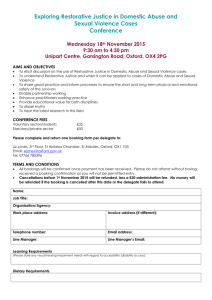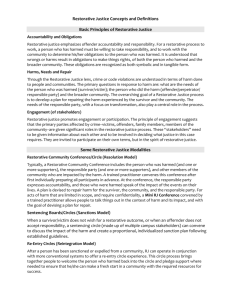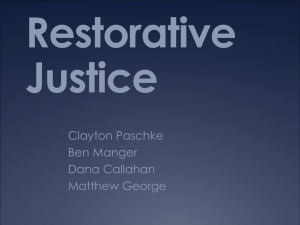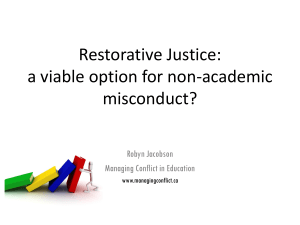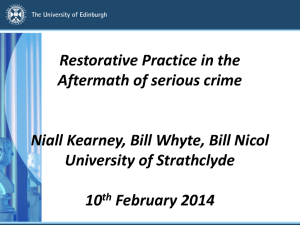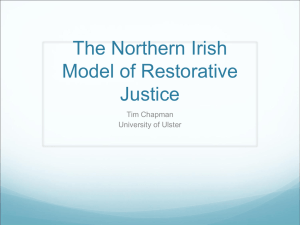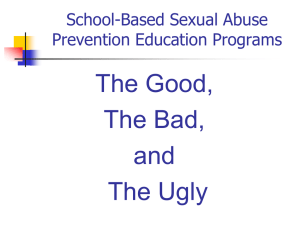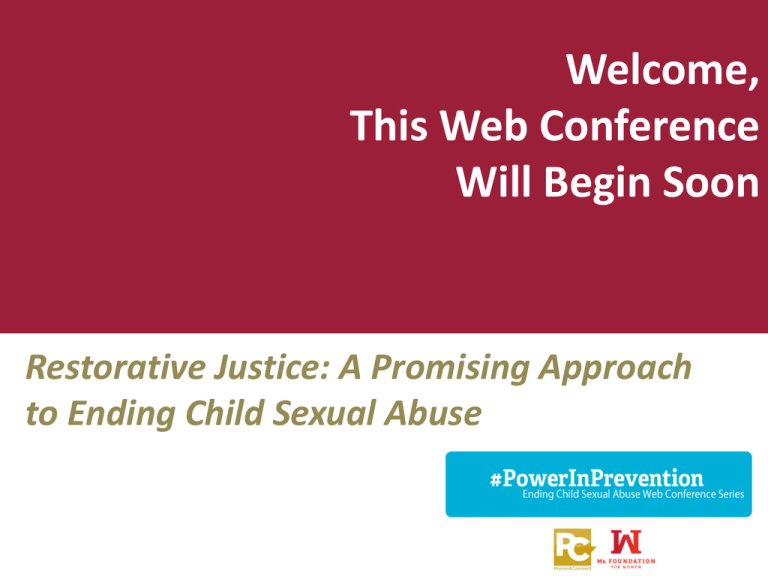
Welcome,
This Web Conference
Will Begin Soon
Restorative Justice: A Promising Approach
to Ending Child Sexual Abuse
Ms. Foundation
12 MetroTech Center
26th Floor
Brooklyn, NY 11201
Website: ms.foundation.org
Facebook: www.facebook.com/MsFoundationforWomen
Twitter: Follow @msfoundation
PreventConnect
1215 K Street
Suite 1850
Sacramento, CA 95814
Website: preventconnect.org
Facebook: www.facebook.com/PreventConnect
Twitter: Follow @PreventConnect
Flickr: www.flickr.com/people/preventconnect
Pinterest: http://forwomen.org/content/127/en/
YouTube: www.youtube.com/CalCASAVideo
YouTube: www.youtube.com/msfoundationforwomen
Email: info@ms.foundation.org
Email: info@preventconnect.org
Email Group: http://groups.yahoo.com/group/Prevent-Connect/
eLearning: learn.preventconnect.org
•
•
•
•
•
•
•
Raise hand
Text chat & private chat
PowerPoint slides
Polling questions
Phone
Closed captioning
Web conference guidelines
• iLinc Technical Support: 800.799.4510
Power In Prevention Ending Child Sexual Abuse Web Conference series is a
national project of PreventConnect and the California Coalition Against Sexual
Assault with support from the Ms. Foundation for Women. The views and
information provided in this web conferences do not necessarily represent the
official views of the Ms. Foundation for Women or CALCASA.
Welcome,
This Web Conference
Will Begin Soon
Cordelia Anderson
Leona Smith Di Faustino
Series Co-Hosts
Joan Tabachnick
Q’s for You
Answer on
the left
Have you attended
prior ECSA?
Q’s for You
Answer on
the left
Does your work
involve a
Restorative Justice
Approach?
What are you
hoping to get out of
this webinar?
Why Restorative Justice?
• “How we respond to sexual abuse
can create the societal and cultural
motivation to prevent child sexual
abuse.”
-- Alisa Klein
Learning Objectives
• Understand the elements of restorative justice
• Learn about the role of survivors
• Understand circle process and its value within
South Asian and other communities
ALL of Us are Affected
Pendulum is Swinging…
Survivor Voices
• “Victims frequently want longer time for
offenders because we haven’t given the
anything else. Or because we don’t ask,
we don’t know what they want. So [the
system] gives them door Number One or
Two, when what they really want is
behind Door Number Three or Four.”
-- Mary Achilles
A Comparison of Each Model
Retributive Justice
• What laws have been
broken?
• Who broke the law
and committed the
crime?
• What punishment do
they deserve?
Restorative Justice
• Who has been hurt?
• What are their needs?
• Who is obligated and
responsible for
meeting those needs?
Not a One Size Fits All Approach
Hollow Water First Nation
Endemic Sexual Violence
• Estimates of victims of CSA: three in four
individuals.
• Estimates of abusers: one in three individuals.
• Virtually no community member untouched by
victimization.
• Many offenders had been victims.
• All victims were acquainted with or related to
their abusers.
Hollow Water First Nation
Community Holistic Circle Healing (CHCH),
• Ojibwa tradition for becoming more whole and
fully integrated.
Hollow Water First Nation
10 Year Evaluation
• Only 2 clients (2%) reoffended over 10 years
• “An impressively low recidivism rate that remains
unmatched in the justice system.” Solicitor General
Aboriginal Justice
• “There is no such thing as a
dispensable person anywhere in this
country. We must quit treating them
as such.”
-- Chief David Keenan, Teslin Tlingit people
Nuri Nusrat,
Program Associate
NCCD Restorative
Justice Project
sujatha baliga,
Director
NCCD Restorative
Justice Project
Paradigm Shift
If we want to solve a problem, we can’t continue to think the
same way we were thinking when we created it.
What Questions Do We Ask About
Wrongdoing?
•
What law was broken?
•
Who broke it?
•
How should they be punished?
Restorative Justice Asks:
• Who has been harmed?
• What are their needs?
• Whose obligation is it to meet those needs?
Who and What Do We Attend To?
Present Legal System
Restorative Justice
What law was broken?
Who was harmed?
Who broke it?
What do they need?
What punishment is
deserved?
Whose obligation is it to meet those
needs?
Person who harmed
All impacted
•
The RJ (Decolonized) Golden Rule
•Do unto others as they would have you do
unto them.
–
–
–
–
(To operationalize this in the wake of harm, ask:
How were you harmed?
What do you need?
Whose obligation is it to meet those needs?)
Sonya Shah’s “Fourth Really”
“If you have come here to
help me, you are wasting
our time. But if you have
come because your
liberation is bound up with
mine, then let us work
together.” ~ Lilla Watson
Why We Don’t Report
#BeenRapedNeverReported
#JusticeFailsASurvivorWhen
A Snapshot of Our Problem
6 People Go To Trial
(6%)
10–18 Incidents Reported to
Authorities
(10–18%)
3 Are Convicted
(3%)
Adapted from Tabachnick & Klein, A Reasoned Approach:
Reshaping Sex Offender Policy To Prevent Child Sexual Abuse
Hollow Water Community Holistic
Circle Healing
Healing Transgenerational CSA
Pandemics
CSA in South Asia
• 53%
• Over Half Are Boys
Diaspora Numbers?
• Links between CSA &
suicidal ideation
• Inability to report
South Asian CSA Survivor Circles
Is There Less Abuse Here Or Less
Reporting?
CSA Estimates in the United States
1 in 4 girls
1 in 6 boys
A Good Place to Begin
• Diverting child-on-child sexual abuse cases to
restorative community conferencing
• Model similar to Family Group Conferencing
(New Zealand Style)
• A success story from Oakland
Exercise Extreme Caution!
• Standards for Facilitating Sexual Harm Cases
• Legal and collateral consequences for
addressing CSA
Parting Restorative Justice Wisdom
Whatever affects one
directly, affects all indirectly.
I can never be what I ought
to be until you are what you
ought to be. This is the
interrelated structure of
reality.
Intersections
How would restorative
justice be useful to
prevention?
Discussion with Speakers
ONE Action
What is ONE action you
can suggest?
• sujatha baliga, Director
• Nuri Nusrat, Program Associate
– NCCD Restorative Justice Project
– nnusrat@nccdglobal.org
Next Web Conference
• Preventing the Harm, Promoting the Helpful:
Healthy Sexuality (January 21, 2015)
• Bridging Knowledge in Child Sexual Abuse
Prevention: Promising Practices in Indigenous
Communities (February 18, 2015)
• Pillars of Policy for Child Sexual Abuse
Prevention: A Discussion (March 18, 2015)

